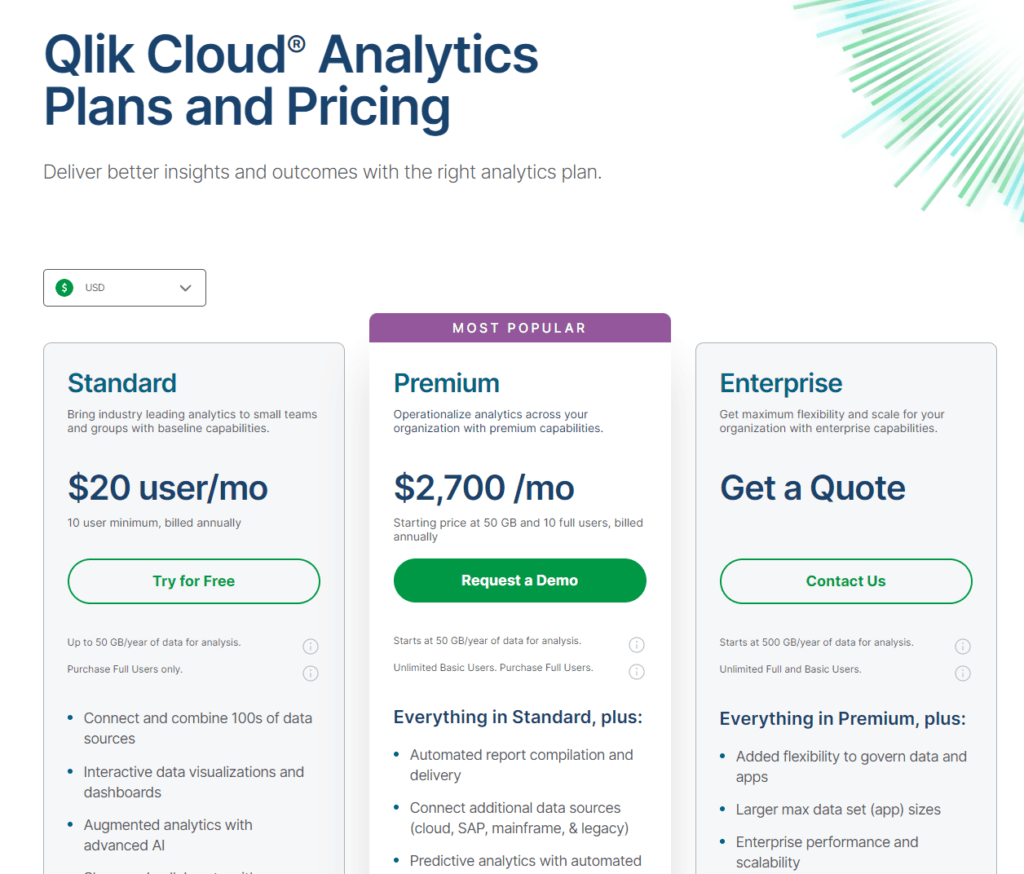Hello there! In today’s fast-paced digital world, the right analytics tool isn’t just helpful—it’s essential for making informed decisions that drive business growth. But in the sea of options, how do you choose the one that’s right for you? Today, we’re putting two giants head to head: Oracle Analytics Cloud and QlikView. Whether you’re a data wizard, a business analyst, or just someone who loves to dig into the numbers, this comparison is crafted just for you. We’re here to cut through the technical jargon and bring you a straightforward look at these tools in a way that’s easy to understand. So, let’s dive right in and uncover which tool might just be your business’s new best friend.
| Oracle Analytics Cloud | QlikView |
|---|---|
 |  |
| G2 Score -4.0 out of 5 | G2 Score -4.1 out of 5 |
| TrustRadius Score -8.1 out of 10 | TrustRadius Score -8.0 out of 10 |
Ease of Use and Learning Curve: Oracle Analytics Cloud vs QlikView
The accessibility of an analytics tool, coupled with how steep the learning curve is, can significantly influence user adoption and the effectiveness of data-driven decision-making within an organization. Let’s assess how Oracle Analytics Cloud (OAC) and QlikView stack up in these areas.
Oracle Analytics Cloud: Streamlined yet Comprehensive
Oracle Analytics Cloud is designed with a focus on providing a comprehensive analytics platform that caters to both novice users and data experts. OAC achieves this through a streamlined interface that simplifies the initial setup and ongoing management of data analytics projects. The tool offers guided workflows, which are particularly helpful for new users, making the process of creating data models, visualizations, and dashboards more intuitive.
However, the breadth of features and advanced capabilities available on OAC can present a steeper learning curve for users unfamiliar with Oracle’s ecosystem or advanced analytics concepts. Oracle tries to mitigate this through extensive documentation, tutorials, and an active user community, but new users may still face a period of adjustment as they become familiar with the platform’s full range of capabilities.
QlikView: Hands-on Discovery with a Learning Curve
QlikView positions itself as a tool that empowers users to take a hands-on approach to data discovery. Its interface is designed to encourage exploration and interaction with data, making it possible for users to dive deep into their analytics without extensive technical knowledge. This user-centric design philosophy helps flatten the learning curve, especially for those who are already familiar with basic data analysis concepts.
That said, mastering QlikView’s more advanced features, such as developing complex data models or customizing dashboards extensively, does require a deeper understanding of the tool. Qlik offers a variety of resources, including training courses and a supportive user community, to help users scale these learning curves. Nonetheless, becoming proficient in leveraging QlikView’s full potential can take time and practice.
Pricing and Value Proposition: Oracle Analytics Cloud vs QlikView
Exploring the pricing structures of Oracle Analytics Cloud (OAC) and QlikView reveals another layer of consideration that can guide organizations toward the best analytics tool for their budget and requirements. Let’s break down the pricing models and what each platform offers in terms of value.
Oracle Analytics Cloud: Enterprise-Level Pricing

Oracle Analytics Cloud is positioned as a comprehensive analytics solution designed to serve enterprises with broad data analytics needs. OAC’s pricing reflects its enterprise orientation, offering a tiered subscription model based on the volume of data processed and the level of computational resources required. While specific pricing details can vary and may require direct consultation with Oracle for the most accurate quotes, it’s understood that OAC is a premium service that includes access to a wide range of advanced analytics capabilities, including AI-driven insights, data visualization, and business intelligence tools.
The value proposition of OAC lies in its extensive suite of analytics tools that can cater to complex, large-scale data environments. Organizations that choose OAC are typically looking for a robust, cloud-based solution that can integrate with other Oracle products and services, offering a seamless analytics experience across their technology stack.
QlikView: Flexible Pricing for a Diverse User Base

QlikView takes a different approach to pricing, offering a flexible model that aims to accommodate businesses of various sizes, from small to enterprise-level. QlikView’s pricing is typically based on a one-time license fee for the software, plus additional costs for maintenance and support services. This allows businesses to invest upfront in the analytics tool and scale their use of the service as needed, without ongoing subscription fees (beyond maintenance and support).
QlikView’s value is in its powerful, user-driven data discovery capabilities, enabling businesses to generate and explore insights through highly interactive, customizable dashboards and reports. The platform is designed to be accessible to users with varying levels of data analytics expertise, making it a versatile choice for organizations that prioritize hands-on data exploration and analysis.
Data Visualization and Dashboards
In the realm of analytics, the ability to visualize data in an intuitive and insightful manner is nothing short of wizardry. It transforms raw numbers into actionable insights. Let’s see how Oracle Analytics Cloud and QlikView perform when it comes to giving life to data through visualization and dashboards.
Oracle Analytics Cloud: A Comprehensive View
Oracle Analytics Cloud (OAC) is like a high-powered telescope, bringing the vast universe of your data into clear focus. It offers a wide range of visualization options, from simple bar charts to complex scatter plots and everything in between. With OAC, you can easily drag and drop different data elements to create custom visualizations that highlight the insights most relevant to your business needs.
What sets OAC apart is its robust dashboard capabilities. These dashboards are not just collections of charts and graphs; they’re interactive data exploration environments. You can drill down into specifics, apply filters, and even incorporate predictive analytics directly within your dashboards. This level of interactivity and depth makes OAC a powerful tool for businesses that require comprehensive analytics solutions that are both accessible and deeply informative.
QlikView: User-Driven Data Discovery
QlikView takes a slightly different approach, emphasizing user-driven data discovery. It’s like being handed a map and a flashlight, empowering you to explore the hidden nooks and crannies of your data landscape. QlikView’s dashboards are highly interactive, designed to facilitate an exploratory approach to data analysis. Users can click, drill down, and interact with the data directly, following their intuition and insights to uncover new paths.
A standout feature of QlikView is its associative data modeling, which illuminates the relationships between different data points. This not only aids in discovering insights but also in understanding the context around them. The tool’s flexibility in creating custom dashboards and visualizations ensures that users can tailor their data exploration experience to their specific needs, making QlikView ideal for businesses that value flexibility and user-driven analysis.

Related: Check out our free SEO suite

Data Security and Compliance: Oracle Analytics Cloud vs QlikView
In an era where data breaches can lead to significant financial penalties and loss of customer trust, the security measures and compliance certifications of analytics platforms are more important than ever. Here’s how OAC and QlikView stand up to the challenge.
Oracle Analytics Cloud: Built on a Foundation of Security
Oracle Analytics Cloud benefits from Oracle’s extensive experience in data management and security. Being part of Oracle’s cloud services, OAC is built on a secure infrastructure designed to protect data at every layer of the technology stack. Oracle employs a wide range of security measures including encryption at rest and in transit, robust access controls, and network security features to safeguard your data.
Furthermore, Oracle’s cloud services comply with a comprehensive set of international and industry-specific compliance standards, including GDPR, HIPAA, SOC 1, SOC 2, and ISO 27001, among others. This commitment to compliance ensures that businesses using OAC can meet their regulatory obligations regarding data protection and privacy.
QlikView: Prioritizing Data Security and Flexible Compliance
QlikView, while not a cloud-native solution like OAC, places a strong emphasis on data security, offering features that ensure data is protected whether at rest or in use. QlikView can be deployed on-premises or in a private cloud environment, giving organizations control over their data security protocols and compliance measures. This flexibility is particularly valuable for businesses in heavily regulated industries or regions with strict data residency requirements.
QlikView supports encryption, access controls, and audit logs to help businesses protect their data and monitor access. While Qlik provides guidance on how to secure QlikView environments, the onus is on businesses to implement these measures effectively, especially when deployed on-premises. Regarding compliance, QlikView’s deployment flexibility enables businesses to tailor their analytics environment to comply with GDPR, HIPAA, and other regulations based on their specific needs.
Scalability and Performance: Oracle Analytics Cloud vs QlikView
As organizations grow, their data analytics needs become more complex, requiring tools that can scale and perform under increasing demands. Let’s compare Oracle Analytics Cloud (OAC) and QlikView in terms of scalability and performance.
Oracle Analytics Cloud: Built for Enterprise Scale
Oracle Analytics Cloud is designed with scalability at its core, leveraging Oracle’s cloud infrastructure to ensure that businesses can scale their analytics capabilities as they grow. OAC’s cloud-based nature means that it can dynamically allocate resources to meet the demands of processing large volumes of data and supporting a high number of concurrent users without degradation in performance.
One of OAC’s strengths is its ability to handle complex data models and large datasets, thanks to Oracle’s powerful data management and processing capabilities. Organizations can integrate data from various sources, including large enterprise systems, without worrying about performance bottlenecks. Additionally, Oracle’s global network of data centers ensures high availability and robust performance across geographies, making OAC a reliable choice for multinational corporations.
QlikView: Flexible Performance with On-Premise Control
QlikView, traditionally deployed on-premises, offers organizations control over their analytics environment, which can be advantageous for scalability and performance management. The performance of QlikView largely depends on the underlying hardware and IT infrastructure managed by the organization, providing flexibility in scaling up resources as needed.
QlikView’s in-memory data processing engine is designed to deliver fast, interactive data analysis, enabling users to explore large datasets with minimal latency. This capability ensures that performance remains consistent as data volumes grow, provided that the organization invests in the necessary hardware upgrades to support increased demands. For businesses with the IT infrastructure and expertise to manage their analytics environment, QlikView offers the advantage of tailored scalability and performance optimization.
Conclusion
Regardless of the tool you choose, the journey towards leveraging analytics for strategic advantage is ongoing. Staying informed about the latest trends in data analytics, continuously evaluating your tools against your evolving business needs, and fostering a culture of data literacy within your organization are key to unlocking the full potential of your analytics investments.
READ NEXT:
- IBM Cognos Analytics vs Optimizely: The Best Analytics Tool for You
- Mouseflow vs Heap: The Best Analytics Tool for You
- Mouseflow vs Mixpanel: The Best Analytics Tool for You
- Hotjar vs Kissmetrics: The Best Analytics Tool for You
- IBM Cognos Analytics vs HubSpot Marketing Analytics: The Best Analytics Tool for You
- 11 Marketing Analytics Tools to Elevate Your Data-Driven Strategies
- 29+ Digital Analytics Software to Skyrocket Your Digital ROI






















Comments are closed.